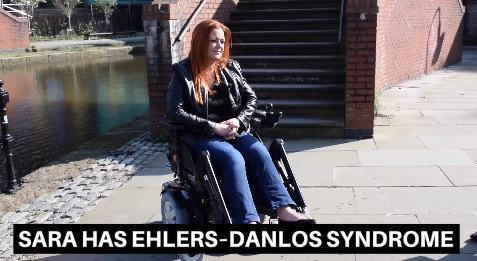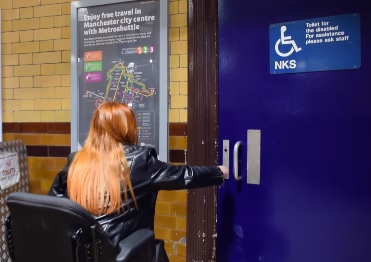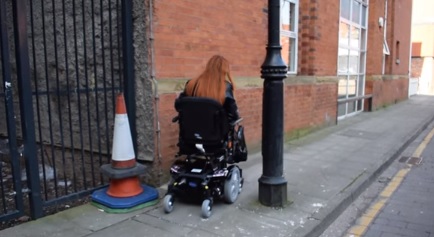How accessible is Manchester city centre to people with disabilities?
- 19.06.2017
- EmmaArnold
- None
Do you know how accessible Manchester city centre is for people with disabilities? We spent the afternoon with one of our clients, who is a wheelchair user, to expose just how inaccessible our city really is…
Manchester is a modern, vibrant city that is constantly evolving. Areas such as the Northern Quarter, attract trendy young professionals with their quirky art galleries, and exciting food, music and cultural events. There is no denying it is an attractive place to live or visit. But swept under its slick, urban appeal lurks an age-old problem that excludes a considerable percentage of the population; large parts of the city are still inaccessible for disabled people.
When we invited our client, Sara, a wheelchair user, to come and join us for an afternoon of filming around the city centre to raise awareness of accessibility barriers for disabled people, she was initially apprehensive.
She explained to us that to travel from her local train station in a Greater Manchester suburb, she would have to contact the train company at least 24 hours in advance to arrange assistance because it is not readily provided at the station. Last minute trips are simply not an option for her on public transport.

She also expressed anxiety at the thought of being in a busy city centre. Sara has Ehlers-Danlos syndrome (EDS), a condition that affects the body’s connective tissue and causes her joints to dislocate from simple actions such as picking up her handbag. She explained that she typically avoids city centres because she does not feel entirely safe.
Despite this, she bravely agreed to drive into the city centre in her specially adapted car to meet us for an afternoon of filming. This is what we uncovered...
Problematic public transport
We decided to pay a visit to one of the city centre train stations. Upon arrival we were greeted by a set of stairs, at the top of which was a sign pointing to an accessible entrance. This wasn’t very helpful, as there was no lift nearby.
Eventually, we went outside and navigated to a different entrance of the same train station - the accessible one. However, the poor signage in and around the station made it difficult to find. Sara doesn’t visit the city centre often, so we had to show her where the accessible entrance was (using prior knowledge), she said she would have been very confused and anxious if the same scenario had unfolded if she was alone.
We then ventured to another popular city centre train station to see if it was more accessible. While a step-free exit was much easier to find, it still posed a challenge. The station is located at the top of a steep hill and Sara did not feel comfortable navigating down the slope safely. She pointed out that her wheelchair is a high quality powered chair (which she only acquired after joining a long waiting list), and that other people using manual, less sturdy chairs would really struggle navigating down the hill. Loose flags and cobblestones further added to her distress. With EDS, going over a cobblestone too quickly can result in her dislocating a joint.
It’s understandable that some older buildings are harder to modify and make accessible, but broken flags on a steep hill leading to one of the city’s most popular public transport stations is simply unacceptable.
Inaccessible ‘disabled’ toilets

Inside one of the city’s train stations, we investigated a public access toilet marked with a wheelchair sign, indicating that it is disabled-access friendly. Sara unlocked the door using her universal disabled access key fob.What was inside shocked all of us.
The door opened to reveal that the allegedly disabled-friendly toilet was being used as a storage facility... for a motorbike! The bike made it much more difficult for Sara to navigate in her wheelchair. The floor inside the tiny toilet cubicle was also wet and slippy, and Sara mentioned that if she were to attempt to use the toilet and fall, it is highly likely that she would suffer a serious injury.
Disabled toilets are supposed to be a safe place for people with disabilities to use the toilet - a basic human right. Employees who abuse their purpose and use them as a storage (or parking!) facility should be disciplined.
Regular checks of disabled toilets should be enforced, to make sure that they are safe and usable. What we witnessed could not even be classed as meeting basic safety levels. Are we going to accept this treatment of disabled people in our society?
Small obstacles add to larger frustrations
We even encountered obstacles while navigating pavements on main and side streets that an able-bodied person wouldn’t even consider to be a problem.
A lamppost erected in the middle of the footpath, and a traffic cone that had been moved from the road to the footpath, both presented challenges as Sara’s only real option was to venture out into the road in her wheelchair to get round the obstacle.

Getting onto the road from the footpath presented a challenge itself, as Sara would have to go back on herself to access the road safely over a dropped curb.
Understandably, this left her feeling frustrated. She mentioned to us that it made her feel like disabled people are treated as an ‘afterthought’, as all the small frustrations add up to make her feel like she doesn’t belong in the city centre.
If there was just a moment that people took to think “would a wheelchair fit through this space?” the city centre would be a much safer and more accessible place. Disabled people are not invisible, they should not be an afterthought.
What message does this send?
Although attitudes towards disability have definitely improved in the 21st century, there are still serious issues in our modern city centres that present huge physical and mental barriers for disabled people. With the construction of more modern infrastructures and buildings comes better accessibility, yet all this hard work is being undone by forgetting the little things like dropped curbs and keeping the pavements clear of obstacles that could prevent a wheelchair user from accessing them.
Disabled people are a huge and important part of our society, and we need and want them in our city centres. To encourage a more accessible and inclusive city, please share our video to raise awareness and put pressure on local councils and businesses to make the city centre a safe and welcome place for people with disabilities.
Should you have any queries about making a clinical negligence or personal injury claim and wish to speak with a member of the team, please contact us on 0161 237 5888.
